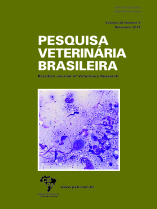 |
|
|
|
Year 2018 - Volume 38, Number 9
|

|
Mastitis in dairy goats from the state of Minas Gerais, Brazil: profiles of farms, risk factors and characterization of bacteria, 38(9):1742-1751
|
ABSTRACT.- Lima M.C., Souza M.C.C., Espeschit I.F., Maciel P.A.C.C., Sousa J.E., Moraes G.F., Ribeiro Filho J.D. & Moreira M.A.S. 2018. Mastitis in dairy goats from the state of Minas Gerais, Brazil: profiles of farms, risk factors and characterization of bacteria. [Mastite em cabras de leite no estado de Minas Gerais: perfil de propriedades, fatores de risco e caracterização de bactérias.] Pesquisa Veterinária Brasilera 38(9):1742-1751. Laboratório de Doenças Bacterianas, Departamento de Veterinária, Universidade Federal de Viçosa, Avenida PH Rolfs s/n, Centro, Viçosa, MG 36570‑900, Brazil. E-mail: masm@ufv.br
The Zona da Mata of Minas Gerais has a specialized goat milk production chain. Goat milk is superior in quality compared with milk of other domestic species, and the demand for milk and milk products for the public has increased. Data on dairy goat breeding in Minas Gerais are scarce and relatively old, and this lack of information has limited the implementation of prophylactic measures, especially for mastitis, which represents the biggest sanitary problem for dairy herds. The objective of this work was to characterize mastitis and bacteria associated with it in milking goats in the Zona da Mata of Minas Gerais. It also causes socioeconomic problems and market issues for dairy goat farming. A total of 539 lactating goats were examined and 268 individual samples (one for teat) were collected from animals positive for strip cup test and/or the California Mastitis Test (CMT). Microbiological cultures were carried out on blood agar medium and the bacteria were subjected to phenotypic, genotypic and antimicrobial susceptibility tests. The prevalence of subclinical mastitis was 28.0% and the clinical prevalence was 2.8%. Bacterial multiplication was obtained in 62% of samples. One hundred eighty seven total bacteria were identified. The most common species identified was Staphylococcus aureus (60%), followed Staphylococcus epidermidis (9.1%,), Escherichia coli (6.9%), Staphylococcus saprophyticus (5.9%) e Staphylococcus caprae (4.3%). Bacteria of the genus Staphylococcus presented a profile of resistance to antimicrobials belonging to the beta-lactam class (penicillin, ampicillin and oxacillin) in addition to tetracycline, in contrast to the other antimicrobials tested. Twelve percent of multidrug resistence (MDR) was found in five microregions. Among the bacteria with the highest prevalence of MDR, 38.5% were E. coli and 10.6% were S. aureus. The producers of the Zona da Mata of Minas Gerais are technicians who work with specialized dairy breeds and practise good management. However, some measures related to prophylaxis and control of diseases, such as vaccination, have low adherence or are not performed due to a lack of veterinary assistance. This is the first study focusing on this region, which is highly prominent in goat milk production in Brazil. It provides important information that can help in the implementation of measures for the prophylaxis and control of diseases, and for maintenance of a constant supply of products in sufficient quantities and of a quality suitable for the consumer population. |
| |
|
|
| |
|
 |